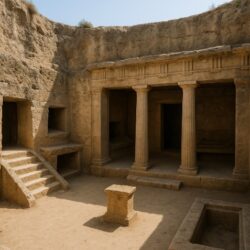Cave di Cusa, located in Sicily, stands as a testament to the engineering prowess and architectural ambition of the ancient Greeks. Serving as the primary stone source for the majestic temples of Selinunte, this ancient quarry offers a rare glimpse into the methods and tools employed in antiquity. The site’s unfinished columns, abandoned in mid-production, speak volumes about the sophistication of ancient craftsmanship and the abrupt historical events that halted its operations.
Historical Context
The Role of Cave di Cusa in Ancient Selinunte
- Time Period: Quarrying at Cave di Cusa began in the 6th century BC during the height of Greek influence in Sicily.
- Purpose: It supplied the limestone blocks and columns for Selinunte’s grand temples, some of the largest in the Greek world.
- Abandonment: Operations ceased abruptly in 409 BC when Selinunte fell to the Carthaginians, leaving the quarry eerily frozen in time.
The Quarrying Process
Techniques of Extraction and Shaping
The massive columns and blocks were carved directly from the bedrock using tools and techniques that remain a subject of fascination and study.
- Marking and Cutting
- Stonecutters marked the bedrock with chisels to outline the desired shape.
- Precise cuts were made to separate the blocks or cylindrical columns from the surrounding rock.
- Shaping the Columns
- Columns were carved in stages, creating their cylindrical shape while still attached to the bedrock.
- The precision achieved with basic tools like chisels and hammers highlights the Greeks’ advanced understanding of geometry and material properties.
- Transport and Placement
- After extraction, the stones were transported approximately 13 km to Selinunte.
- The exact methods of moving these massive stones remain debated, with theories ranging from sledges and rollers to more sophisticated engineering systems.
Unfinished Columns: A Snapshot of History
Cave di Cusa is most famous for its unfinished columns, which remain in various stages of production:
- Partially Detached Columns: Some columns are only partially separated from the bedrock, showcasing the initial steps of extraction.
- Rough-Cut Shapes: Others are fully detached but not yet smoothed, revealing the progression of shaping.
- Abandoned Transport: A few columns lie scattered across the site, abandoned as they were being prepared for transport.
These remnants offer a unique, open-air museum of ancient craftsmanship, providing a visual narrative of the quarrying process.
Engineering Ingenuity
Precision Without Modern Tools
- The symmetry and uniformity of the columns reflect a deep understanding of engineering principles.
- The techniques employed remain impressive even by today’s standards, underscoring the Greeks’ mastery of manual labor and geometry.
Logistical Challenges
Moving multi-ton stone blocks over significant distances posed immense challenges. The Greeks likely employed ingenious solutions, though the specifics remain a topic of scholarly debate.
Cultural and Archaeological Significance
A Window into Ancient Greece
- Cave di Cusa offers unparalleled insight into the construction practices of ancient Greece.
- The site illustrates the integration of technical skill with aesthetic ambition in creating monumental architecture.
Preservation of History
- The sudden cessation of work in 409 BC preserved the site as a historical snapshot.
- The abandoned columns stand as silent witnesses to a pivotal moment in Sicilian history.
Tourism and Modern Relevance
A Site of Fascination
- Cave di Cusa is a popular destination for history enthusiasts and archaeologists.
- Its unfinished columns and tranquil setting make it a compelling attraction.
Educational Value
The site serves as an open classroom for understanding ancient engineering, architecture, and the cultural heritage of Sicily.

Challenges and Conservation
Natural Erosion
Exposure to the elements threatens the integrity of the site, necessitating ongoing conservation efforts.
Tourism Impact
While tourism brings awareness, it also poses risks to the preservation of the delicate artifacts and structures.



















